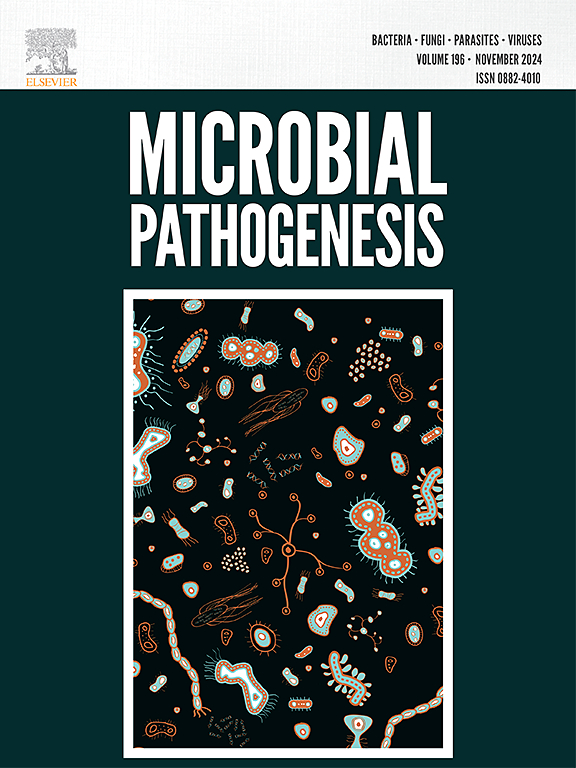葡萄球菌肠毒素C和TSST-1在牛乳腺上皮细胞感染中的潜在作用。
IF 3.5
3区 医学
Q3 IMMUNOLOGY
引用次数: 0
摘要
牛乳腺炎是乳制品行业的一个持续问题。这种感染对动物的健康和福利产生重大影响,并给农民和乳制品行业造成经济损失。与牛乳腺炎相关的关键细菌是金黄色葡萄球菌(金黄色葡萄球菌)。它产生不同的外毒素,包括超过24种不同的葡萄球菌肠毒素和中毒性休克综合征毒素-1 (TSST-1)。我们研究了肠毒素C (SEC)和tst -1在感染过程中的作用。从牛乳腺炎病例中分离的三种野生型菌株构建了五种不同的金黄色葡萄球菌sec或test -1缺失突变体,并对其生长和肠毒素形成进行了表征。利用这些突变型和野生型菌株感染牛乳腺上皮细胞(BME-UV),评价它们的感染能力。计算感染7 h后BME-UV细胞裂解液中回收的金黄色葡萄球菌与初始金黄色葡萄球菌感染剂量的比率,以衡量每种菌株的感染能力。sec基因的缺失总体上降低了侵染率,提示sec基因的存在可能在侵染过程中发挥了作用。相比之下,删除test -1似乎对感染能力没有同样程度的影响。蛋白质组学分析表明,三种金黄色葡萄球菌野生型菌株中的两种感染引起BME-UV细胞蛋白质组的系统性改变。与野生型感染细胞相比,这两种野生型菌株的等基因片段缺失突变体也产生了BME-UV细胞蛋白质组的差异。总之,感染比例的降低和蛋白谱的改变表明SEC可能在BME-UV细胞的金黄色葡萄球菌感染过程中发挥作用,而TSST-1的作用尚不清楚。进一步研究它们的特定功能对于阐明这些毒素是否是新的预防策略或治疗牛乳腺炎的潜在目标是很重要的。本文章由计算机程序翻译,如有差异,请以英文原文为准。
The potential role of Staphylococcal enterotoxin C and TSST-1 in the infection of bovine mammary epithelial cells
Bovine mastitis is a continuous problem in the dairy industry. The infection has significant impact on health and welfare of animals and causes financial losses for the farmers and the dairy industry. A key bacterium associated with bovine mastitis is Staphylococcus aureus (S. aureus). It produces different exotoxins including more than 24 different staphylococcal enterotoxins and toxic shock syndrome toxin-1 (TSST-1). We have investigated the role of enterotoxin C (SEC) and TSST-1 in the infection process. Five different S. aureus sec or tst-1 deletion mutants, derived from three wild type strains isolated from cases of bovine mastitis, were constructed and characterized regarding growth and enterotoxin formation. These mutant and wild type strains were used to infect bovine mammary epithelial (BME-UV) cells to evaluate their infection ability. The ratio of S. aureus recovered in BME-UV cell lysate after 7 h of infection to the initial S. aureus infection dose was calculated to provide a measure of infection capability of each strain. Deletion of the sec gene overall showed a reduction in infection ratio, suggesting that presence of SEC may play a role during the establishment of infection. In contrast, deletion of tst-1 did not appear to affect the infection capability to the same extent. Proteomic analyses indicated that infection by two out of three S. aureus wild type strains elicited a systematic alteration in the BME-UV cell proteome. The isogenic sec deletion mutants of these two wild type strain also produced differences in the proteome of the BME-UV cells compared to the wild-type infected cells. Altogether the reduced infection ratios and altered protein profiles suggest that SEC can play a role in the S. aureus infection process of BME-UV cells while a role for TSST-1 still remains unclear. Further investigations of their specific functions is important to elucidate if these toxins are potential targets in new preventive strategies or treatments for bovine mastitis.
求助全文
通过发布文献求助,成功后即可免费获取论文全文。
去求助
来源期刊

Microbial pathogenesis
医学-免疫学
CiteScore
7.40
自引率
2.60%
发文量
472
审稿时长
56 days
期刊介绍:
Microbial Pathogenesis publishes original contributions and reviews about the molecular and cellular mechanisms of infectious diseases. It covers microbiology, host-pathogen interaction and immunology related to infectious agents, including bacteria, fungi, viruses and protozoa. It also accepts papers in the field of clinical microbiology, with the exception of case reports.
Research Areas Include:
-Pathogenesis
-Virulence factors
-Host susceptibility or resistance
-Immune mechanisms
-Identification, cloning and sequencing of relevant genes
-Genetic studies
-Viruses, prokaryotic organisms and protozoa
-Microbiota
-Systems biology related to infectious diseases
-Targets for vaccine design (pre-clinical studies)
 求助内容:
求助内容: 应助结果提醒方式:
应助结果提醒方式:


